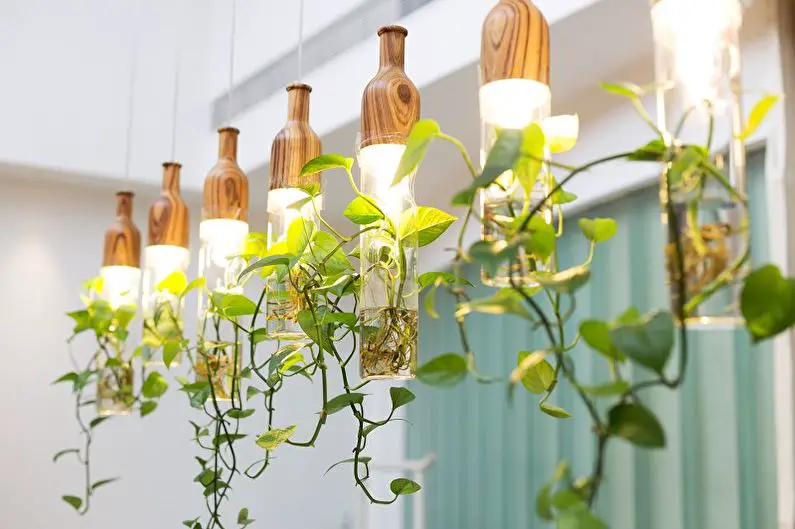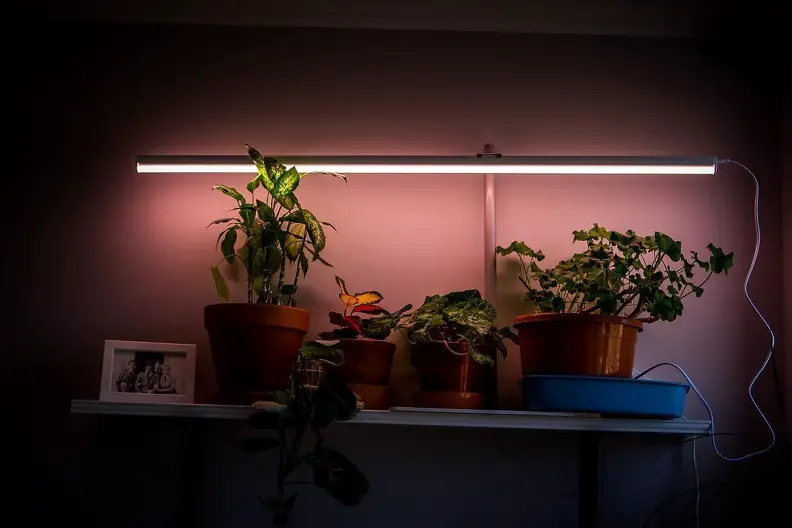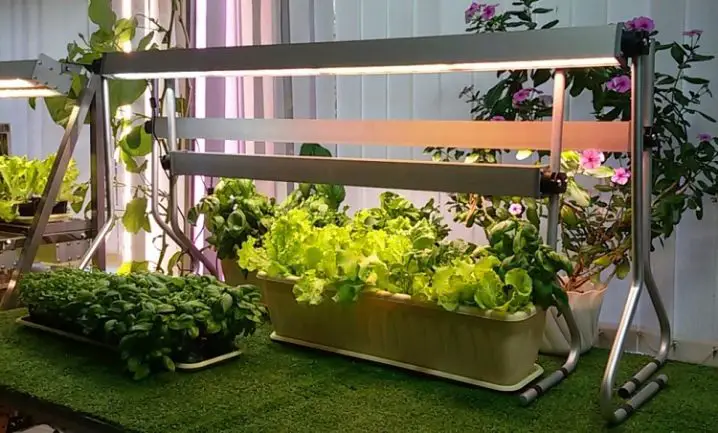In their natural habitat, plants absorb as much solar energy as they should. At home, there is always less light, especially in winter, when almost all colors need additional lighting. We figure out what kind of lighting should be for flowers, types of grow lights for indoor plants, and which lighting fixtures are better to use.

Types Of Grow Lights For Indoor Plants
Several types of grow lights for indoor plants are used to improve plant growth and development. These include both special photo lamps and household appliances, each with its own set of properties.
Incandescent lamps
The main feature of such devices is economic inefficiency and low service life, which is balanced by the budgetary cost. Most of the electrical energy is not converted to light, but to heat. For this reason, they should not be placed too close to pots and containers: both the leaves and the ground will dry out. If the distance is increased, the intensity of the light flux decreases, and conditions are created that are insufficient for most species.

Incandescent lamps cannot be a complete substitute for sunlight. Their spectrum is rich in red light, but blue waves are practically absent in it (glass retains ultraviolet light). Such lighting devices are not suitable as a single source but can be used in combination with a fluorescent lamp, complementing its spectrum with the red light.
In greenhouses, where there is ample space, incandescent lamps can be used to heat the air. Some models have a built-in reflector; they are more useful for use as phytolamps, as they create more comfortable conditions.
If you want to know about How To Fix Hard Water For Plants?
Fluorescent lamps
The first fluorescent lamps were bulky and not very convenient, but later compact models appeared. They are useful for growing small flowers and growing seedlings in confined spaces. They are also suitable as an additional source if there is not enough light from the window.
Fluorescent lamps are optimized for home use. Their service life reaches 10 thousand hours, while an incandescent lamp lives, on average, about 1,000 hours. They are cheaper to operate, efficiently convert electrical energy into light, and emit relatively little heat.

Their emission spectrum lies mainly in the blue and red parts, but the radiation intensity is rather weak. Therefore, in order to maximize the benefits, the lamps are placed very close to the foliage.
In stores, fluorescent lamps are available, of various lengths of the bulb (tube), diameter, type of base. The power and color temperatures also differ, the most common color formats are 4000 K and 6500 K. For indoor flora, the purchase of a T12 fluorescent lamp would be a suitable solution. The T5 model (smaller diameter) emits the higher intensity light needed for light-loving plants.
See also Best Feng Shui Indoor Plants.
LEDs (LED-lamps)
LED lamps differ in their characteristics. They are more expensive, but during operation they work economically due to their high efficiency (90-95%). They last 4-5 times longer than fluorescent lamps, 45-50 thousand hours; even especially light-loving flora, such a lamp will illuminate for 7-9 years.
Light-emitting diodes provide high radiation intensity; at the same time, they practically do not heat up themselves and do not heat the leaves and stems. Additional advantages of LED devices are their environmental friendliness (they do not contain substances hazardous to health) and the ability to work at low voltage.
The range of standard LED bulbs from the store is not suitable for growing plants. There are LED sources with a special spectrum (red and blue) or with adjustable wavelengths, suitable for use in floriculture. They are chosen based on the tasks: for general use, LED sources with a wavelength of 430 nm (white light) are suitable, for vegetation or growth, an LED lamp with a wavelength of 450-455 nm (blue) is chosen. During the flowering period, an LED covering the spectrum of 600-700 nm (red) will be useful.
Discharge Lamps (HID)
Before LED lamps appeared on the market, gas discharge sources were the only viable option for servicing large greenhouses. They differ in power, and they convert electricity into light 8-10 times more efficiently than incandescent lamps, in which, however, they are inferior to LEDs.
The flask can be filled with various inert gases, metal vapors (sodium, mercury) or mixtures thereof. Most effective are sodium lamps (HPS), which emit low (red) spectrum radiation and are suitable for maintaining flowering. Another type, metal halide (MH) lamps, emit a high spectrum and are convenient for improving vegetative growth.
HID bulbs are durable and powerful, but they generate a lot of heat and cannot be dimmed. They are also distinguished by their large size and relatively high cost, and require the use of ballasts and cooling systems.
The combination of characteristics makes HID lamps convenient for use in greenhouses, and impractical for home use. The HID lamp can be used at home if you have enough space to grow large plants such as citrus fruits or tomatoes.
Check it out Beneficial Plants For Home.
Effect of light on plants
Under the influence of light in green leaves from carbon dioxide and water, carbohydrates are formed, substances vital for the successful development of plants. It is light energy that triggers this process, photosynthesis; when there is not enough light, it slows down. This affects the appearance of flowers: the leaves lose their color, the shoots become thinner and grow poorly, the flowering weakens.

A significant part of the world is located in regions with a long winter period. In winter, daylight hours become shorter, and there is not enough natural light even for flowers on the southern windowsill; plants located more than a meter from the window are especially affected.
Also like DIY Self-Watering System For Indoor Plants.
In order to support the normal development of plants, additional lighting is needed. The problem is that the need for light is different for different colors, and they react differently to both lacks of light and excess.
When do plants need artificial light?
So that the installation of additional lighting does not become an unjustified waste of the family budget, it is useful to find out when it is really needed. Plants cannot do without additional lighting in the following cases:
- If in a given area the number of cloudy days prevails over the number of sunny days.
- If the flowers are kept on a windowsill, but due to an unfortunate location (north side), direct sunlight is delayed for less than 3.5 hours.
- In the autumn-winter period in regions with a shortened daylight hours (more northern territories), if the temperature of the content exceeds 22 ° C.
Artificial lighting will be beneficial if it meets the following criteria:
- It will be of high quality. Sunlight is composed of waves of different lengths. They form a full spectrum ranging from short ultraviolet to long infrared. Artificial lighting should match the sunlight as much as possible. The task is complicated by the fact that at different periods of life, flowers are useful waves of different lengths (from different parts of the spectrum).
- Will have the desired duration. For different species, the favorable day length is different, and this must be taken into account when choosing a lighting mode. Some flowers are capable of flowering only if they are exposed to light for 12-14 hours a day; others need 8-10 hours.
- Will have the right intensity. The need for light differs from species to species, and ranges from 10,000 lux (bright) to 3,000 (weak) light.
- Will have a periodicity. In nature, everything is cyclical, therefore, not only the parameters of light are important for domestic plants, but also the frequency of its appearance.
how to use grow lights for indoor plants?
It is not just each factor that matters, but the right combination of them. When organizing artificial lighting, it is necessary to provide both the required amount of light and the correct alternation of light and dark periods. For example, if you illuminate light-loving species with a low-power lamp, they can get sick, even with the right day length.
For active development and flowering, different species need illumination within the following limits:
- Bright light (8-10 thousand lux). The need for bright light is found in cacti, palms and orchids. Loves light rose, bougainvillea, hibiscus and pelargonium.
- Moderate (4-6 thousand lux). Some cacti and palms, Kalanchoe, hibiscus, ivy, amaryllis, chrysanthemum, begonia.
- Weak (1-3 thousand lux). In low light, fern, tradescantia, dracaena, spattifillum, echinanthus, diphenbachia feel good.
For the development of plants, such a parameter of light as its spectral composition is important. Sunlight is not uniform; it contains rays of different wavelengths. The spectrum is conventionally divided into two types:
- Warm (longwave, red and orange). The length of orange rays is 620-595 nm, red – 720-600 nm. The color temperature is 2700-3000 K.
- Cool (shortwave, blue and purple). The wavelength ranges from 490-380 nm. The color temperature is around 4000-6500K.
Both parts of the spectrum are needed for color development, but they have different effects. Artificial light bulbs designed for plants are marked with numbers, and the higher the number, the colder the light.
Dedicated light bulbs help solve the following problems:
- Red and orange spectrum. The rays are responsible for the processes of photosynthesis, affect the rate of growth and development, are responsible for flowering and fruiting. They will be useful if you want to plant flowers or, for example, lemons, tomatoes or peppers. The rays of the warm spectrum are useful for the growth of the root system, as well as in preparation for flowering.
- Blue and especially violet spectrum. They also take part in photosynthesis but additionally stimulate the formation of proteins and the growth of the green mass of leaves. The cold spectrum is useful if you plan to grow greens or seedlings; it will be enough for root crops. Under the rays of a cold spectrum lamp, varieties that in nature are accustomed to short daylight hours will bloom faster.
Warm rays are also responsible for the synthesis of vitamins; they also prevent the flowers from stretching too much. The harder UV light increases the resistance to cold. Green and yellow rays have minimal impact and are not vital to indoor flora.
Lighting for indoor plants does not have to be highly specialized. Full-spectrum lighting can be used in most cases; this will make life much easier.
Check out how to sterilize garden soil for indoor plants?
what happens if a plant doesn’t get enough sunlight?
The appearance of indoor flora is a reliable indicator of whether it has enough light. The reasons for poor growth may have other origins, but you should think about the lack of lighting if the following symptoms are observed in flowers:
- Leaves grow smaller than usual.
- The color of the leaves and stems becomes less intense.
- The distance between two adjacent nodes (leaf growth points) is too large, the plant seems to be reaching for the light.
- The lower leaves begin to turn yellow, the variegated ones turn green.
To get a reliable picture of the illumination, measurements are taken using special devices. For home conditions, a household photometer or light meter (for example, a RADEX LUPIN light meter) is suitable. Household devices are easy to use; they will help you organize the optimal lighting conditions. An alternative solution can be a specialized application that can be downloaded from the Play Market or a similar store. It will take measurements using a smartphone camera.
If measurements have shown that the illumination level is almost correct, then the lamps do not need to be replaced. The use of available artificial light can be maximized. Reflectors (reflectors) will help with this. They are made of metal (usually aluminum) with different coatings; can be floor-standing or suspended, and significantly improve the quality of plant illumination.
Summery
Houseplants often lack sunlight, so they need artificial lighting. To bring its parameters in line with the needs of indoor flora, you need to know what conditions are needed for one or another species.
An important parameter is the brightness (intensity, power) of the luminous flux. The spectrum emitted by the lamp is also important for the development of plants. Distinguish between warm and cold parts of the spectrum, and both are needed by flowers at different periods of development.
To provide a suitable light regime, several types of grow lights for indoor plants are used. For home gardening, fluorescent lamps are a popular choice. You can find out whether plants receive enough light by their appearance, as well as using a household light meter or a specialized application.
